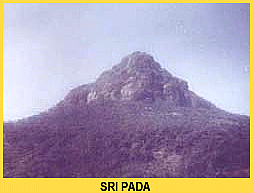

mailto: payer@hdm-stuttgart.de
Zitierweise / cite as:
Mahanama <6. Jhdt n. Chr.>: Mahavamsa : die große Chronik Sri Lankas / übersetzt und erläutert von Alois Payer. -- 15.E2. Exkurs 2 zu Kapitel 15: Sīmā -- Fassung vom 2001-06-21. -- URL: http://www.payer.de/mahavamsa/chronik15e2.htm. -- [Stichwort].
Erstmals publiziert: 2001-06-21
Überarbeitungen:
Anlass: Lehrveranstaltung, Universität Tübingen, Sommersemester 2001
Unterrichtsmaterialien (gemäß § 46 (1) UrhG)
©opyright: Dieser Text steht der Allgemeinheit zur Verfügung. Eine Verwertung in Publikationen, die über übliche Zitate hinausgeht, bedarf der ausdrücklichen Genehmigung der Herausgeberin.
Dieser Text ist Teil der Abteilung Buddhismus von Tüpfli's Global Village Library
Zum tieferen Verständnis der verschiedenen Erwähnungen von Grenzen (sīmā) für ordensrechtliche Zwecke, sei hier die Darstellung aus dem grundlegenden thailändischen Lehrbuch des Ordensrechts voll wiedergegeben:
Vajirañānavarorasa: The entrance to the Vinaya = Vinayamukha. -- [Transl. from Thai]. -- Bangkok : Mahāmaku.tarājavidyālaya
Vol. 3. -- 2526 = 1983. -- [The managment of the Sangha]. -- S. 14 - 52
Die Zeremonien und Rechtsakte, wie sie heute in Thailand praktiziert werden, sind ausführlich dargestellt in:
Wells, Kenneth E.: Thai Buddhism : its rites and activities. -- 3rd printing (updated). -- Bangkok : Suriyabun Publishers, 1975. -- S. 178 - 183.
This chapter is complex and difficult. For ease of reference, current practice in Thailand with regards to sīmā is briefly outlined here.
- Well-established monasteries, when wishing to build an Uposatha- hall, apply io the authorities requesting that the area for the hall and its surroundings be declared visungāmasīmā by Royal Decree. If this is granted, the chanting to give up ticīvara: avippavāsa and samānasamvāsa-sīmā is done. Large round stone balls are buried, usually four along each long side of the hall and one in the centre and noted as nimitta. Finally the chanting to determine samānasamvāsa-sīmā and ticīvara-avippavāsa is done: it is then a determined Baddhasīmā.
- Monasteries without such a formally-determined boundary most often perform sanghakamma in one of their main buildings: if any reference to the sīmā occurs in some sangha-kamma, the word abaddhasīmā or just sīmā.may be used.
- The sīmā limited by water (udakukkhepa) has been used on special occasions, particularly when doubt has arisen about the validity of sanghakamma.
Other types of sīmā discussed are seldom, if ever, used in the present, so the general reader may perhaps refer to this chapter selectively
The Great Teacher allowed the sangha having preparedness. to perform Uposatha, Pavāranā, and all other Sanghakamma. How is the preparedness of the sangha determined? This is defined easily by assembling together in one place. Any number of bhikkhus living in the same place must meet together and perform that sanghakamma. How, then, does one consider what living in one place means? It is difficult to determine if it extends to living in one kuti, in the same compound, in the same monastery, in the same district, or in the same city. This must be determined by a known boundary, which is called sīmā. There are two kinds of sīmā:
Sīmā is an important factor in sanghakamma. Though the other factors of sanghakamma are complete, if it is defective through sīmā it js invalid. This is a strict regulation which I understand is for the protection of the sāmaggī (concord) of the sangha. Concord is the main strength of a group. Lacking concord, the group will not be stable.
Now I shall explain these two sīmā respectively. .
[The Lord Buddha] allowed the sangha to determine the area as it wishes, but that area is limited by a minimum and a maximum size.
Sīmā which are smaller than or larger than these are defective and cannot be used.
Why did he prohibit a sīmā which is so small that it cannot accommodate twenty-one bhikkhus? This is easily understood because the sanghakamma which requires the largest number of bhikkhus, twenty, is abbhāna, the chanting to stop the sanghādisesa-āpatti of a bhikkhu. In counting that (guilty) bhikkhu, the number is twenty-one. A sīmā which is too small is not large enough for the performing of abbhāna.
Why (did he) prohibit a sīmā which is larger than three yojana? I understand that it is beyond what can be looked after. But if someone asked the question as to why the sangha wished to determine a sīmā of so large an area, it is difficult to answer. Apparently, there must be some worthwhile benefits for the sangha [to wish] to do so. What benefits? It could be understood that such enlargement expands the area of not being separate from the three cīvara -- but this seems insufficient. It would be more beneficial if it is a way to expand the area of nissaya (dependence). At present, that area is limited to each monastery, causing difficulty for the bhikkhu who gives nissaya when it is necessary to stay further apart. Supposing those wats were within the same sīmā, and the area of nissaya was expanded accordingly, it would certainly be a little more convenient. However, three yojana stretches the area of nissaya too far. If that area is land claimed by the sangha from the civil authorities, they hold the rights over things coming from that land. For example, their permission must be asked to cut the timber on that land or mine the ore, as is done at present. These examples are appropriate, but in the Lord Buddha's time it was not meant in this way. If these were meant, they were surely limits laid down later. I request the Vinaya-experts to look into this.
The area which the sangha determines as a sīmā should be seen as the area of ownership, in the same way as the area for the construction of kutis in the 6th and 7th Sanghādisesa training rules. However, the formula for determining the sīmā as land for not being separated from the three cīvara, called ticīvara-avippavāsa, suggests that this is not so. In that formula, villages and their compounds are excepted. It is explained that the area determined as that sīmā by the sangha has villages within it. When the sangha determines that sīmā as the land for not being separated from the three cīvara, the sangha excepts those villages and their compounds. The area outside those villages and compounds is the ticīvara-avippavāsa, and that would be forested area unclaimed by anyone.
There are examples in the Mahāvamsa, the historical chronicle of Sri Lanka. It is said that King Devānampiyatissa allowed the sangha to determine the area of Anurādhapura as a sīmā so that he would be able to remain within the sangha land. In Pāli it speaks of many monasteries (avāsa) within the same sīmā. According to the above-mentioned examples, it is understood that the sangha does not hold ownership rights to the area which it determines. It is determined as an area for the performance of religious duties, such as religious missions do at the present. In those countries that give permission, they can carry out their business in their own section, being unconcerned with politics. The sangha in those days would have been the same. These examples agree with the gāma-sīmā and nigama-sīmā in the section on abaddha-sīmā, which I shall explain below. As time passed, the area of baddha-sīmā has gradually become limited until it has become claimed land and one must receive permission from the kingdom.
It is the tradition that the determined area must be marked by various objects. In determining the area of the sīmā, (the Lord Buddha) allowed the area to be marked off with materials called nimitta, which means mark. The Pāli mentions eight kinds of materials which can be used as nimitta
The marking of the sīmā with nimitta could be such as:
in the east it extends from such-and-such a river to such-and-such a lagoon; in the south, from such-and-such a hill to such-and-such a range of rocks; in the west, to such-and-such a path; in the north, to the edge of such-and-such a grove.
The use of these six kinds of nimitta suggests that in those days the areas of sīmā were large. Sīmā can be marked with these six objects as nimitta.
Rocks, trees, ant-hills, ponds or wells, are also permanent things, but they are smaller than the six mentioned above. I understand that they are used as nimitta of sīmā located on mountains or in jungles which cannot be marked by groves or hills. Moreover, they are used in areas where larger objects are not available.
The Atthakatha-Ācariyas give these eight nimitta which can be explained as follows:
a) and b) three kinds of hills
These three can be used as nimitta. Pure rocks or rocks mixed with ore can both be used. They are not as large in size as an elephant, but they are of the size of a large cow- or buffalo-head and are one piece of rock. The minimum size to be used is equal to 32 stalks of sugar-cane.
A heap of stones, small rocks heaped up into a hill or something similar, cannot be used. A rock ledge, a range of rocks, and a pinnacle-shaped rock rising high above the ground can be used. The Commentators prohibited from use rocks which are bigger than an elephant as nimitta because they judged such rocks to be hills, to be named as hills, not rocks, when being determined. The smallest size rock which can be used is limited to 32 stalks of sugar-cane [bound together] and which weigh about five chang [about 3 kg], which seems to be too small.
c) and d) Regarding groves of trees, they suggest the use of of trees with hard heartwood: teak and (Thai) Sāla (Pentacme siamensis), and similar kinds of hardwood trees, that is, having hard heartwood. They did not give examples of these, but the banyan and mango seem suitable. Groups of four or five such hardwood trees can be used. Trees with a hard bark covering but a pithy inside such as Palmyra palms and coconut palms, were prohibited from use. Palmyra palms, however, are long-lived and are used in marking off the boundaries of fields, and perhaps may be used. A single tree comparable to a grove may be used. In this same section, the Commentators explain that a living hardwood tree which is only eight inches high, the stalk of which is like a needle, is suitable, but that it must have grown in the ground or been transplanted already; if it is still in a pot, even though appropriate in size and type, it cannot be used. They allow such small trees, although they can grow larger! I consider this to be careless (because such objects do not have the permanence necesary to be a nimitta) and not a sufficient indication.
e) Paths. A footpath or a cart-track still in use can be used as a nimitta. A path of the length of two or three villages can be used. Paths which split from the main path and which join up again a short distance later and disused paths are prohibited from use.
f) Ant-hills. The Commentators have given the minimum size to be used as eight inches, even though built on that day. Its shape is equal to a bull's horn. This statement is also careless.
g) I shall explain rivers below in the udakukkhepa-sīmā in the section on abaddha-sīmā.
h) Water means the still water in lagoons, marshes, ponds or wells. In the old commentary called the Andhaka-Atthakathā it is prohibited to take the water in a deep well in which a pulley or something similar is used to draw out water as a nimitta. It is explained that in such wells the amount of water is very little and they can go dry. The ācariya who composed the Commentary on the Mahāvagga opposes that explanation as unsuitable, calling it only the author's own opinion. He himself explained still water as even that in a wallow dug by pigs in a children's playground, or even water which is brought by pot and poured into a pit which was dug that moment. If that water can remain until the end of the chanting of the kammavāca, however small an amount remains, this can be used. But in that place, he added, it is proper to construct a pile of rocks or a sand-hill or an earthen-hill, or a fixed rock, or a wooden pole as a marker. I am amazed that the Ācariya who composed the Mahavagga-commentary dared to contradict a reasonable view so strongly and shamelessly, while (himself) comparing vinaya-kamma with playthings. He completely misunderstands the flavour (or the passage); it is quite disturbing.
These objects are limited to being nimitta on one side only, and are prohibited from being used on another side. For example, the same path or the same river encircling the sīmā, on many sides if determined as nimitta on one side, is prohibited from being determined again on another side. However, they are used in marking a country's borders: after consideration, I can see no objection -- these objects may be used either similarly or differently from the rest. Other objects, besides these eight kinds, are prohibited from use as nimitta and though they are used, they are not counted as nimitta.
These nimitta are not clearly limited as to how many but inferences can be drawn. There must be at least three in order to be used. There is no maximum limit. If there are only two the (boundary) lines will not meet -- this cannot be done A sīmā which has three nimitta has the shape of a triangle with four nimitta is quadrangular. There are various four-sided shapes. Sīmā with many nimitta are of various shapes. Below are drawings to illustrate this.
Simajyith three nimitta are triangular in shape, like this:
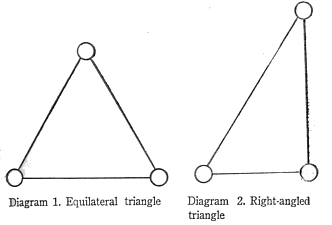
Abb.: Diagram 1, 2
Sīmā with four nimitta are quadrangular in various shapes, such as these:
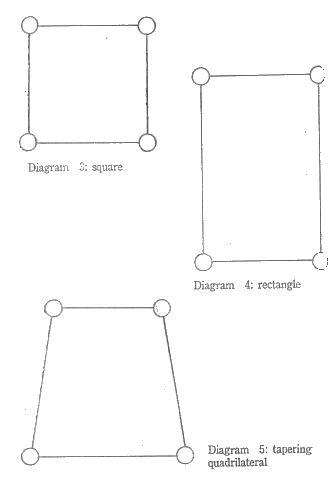
Abb.: Diagram 3 - 5
Sīmā with six nimitta have various shapes, as follows:
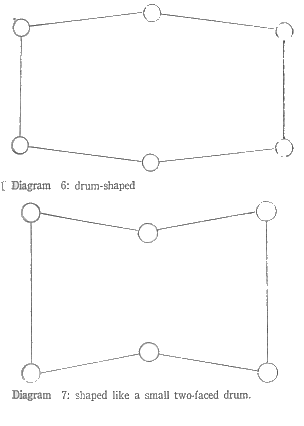
Abb.: Diagram 6 - 7
In the Pāli of the Parivara Scripture, it is stated that the determined sīmā which is incomplete in nimitta, having a shadow as a nimitta, or without any nimitta at all is, a defective sīmā (sīmā-vipatti).
The sīmā which is incomplete in nimitta, having only one side with nimitta and which cannot be linked to the other sides, cannot be used. The following is an example:
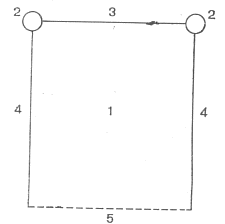
Abb.: Diagram 8
1. Area of sīmā
2. Nimitta
3. Line between the nimitta
4. Lines with no completing nimitta
5. Missing line
It is explained that the space between the two nimitta can be joined together as marked in (3). The space outside may continue as a straight line as can be seen in (4) but where they terminate cannot be fixed, so the opposite side as shown in (5) cannot be found. Such is the sīmā which is incomplete in nimitta -- even though having more than two nimitta, yet if the lines are incomplete, it cannot be used.
In the Atthakathā, however, the explanation (of incomplete sīmā) is concerned with the method of outlining it. Noting the nimitta in succession, beginning from the east and continuing to the north, but stopping there without returning to renote the nimitta in the east, is called incomplete in nimitta. I would compare their view to the incomplete scattering of sand in a circle. This explanation is not worth following as it is only approximate, but through repeated practice it has become a tradition. If we make a mistake, it will be regarded as a defective sīmā. The Commentators have explained further that those other materials which properly should not be determined as nimitta, such as a tree with hard bark but pithy inside, a stump, a pile of soil or a pile of sand (if) found inside the space of that sīmā, can be determined as khandha-nimitta (subsidiary-nimitta). This latter explanation is reasonable. One should take their explanation to mean this: It is decided to determine a square sīmā but other materials are taken as nimitta between, then that area is called lacking nimitta. The shape of the sīmā, is changed from the proposed original shape until it is not usable. I will give the following diagaram to illustrate:
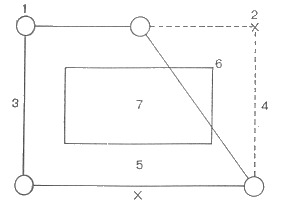
Abb.: Diagram 9: Sīmā of changed shape (defective)
1. Usable nimitta
2. Unusable nimitta
3. Linked boundary of sīmā
4. Excluded boundary
5. Actual area determined as sīmā
6. Area cut off
7. Uposatha hall.
The sīmā with a shadow as a nimitta: the Atthakathā Ācariyas explain it as taking any shadow, such as the shadow of a hill, etc., as a nimitta. I disagree with them. One way to interpret it is to take a line as a nimitta. Why is the term chāya (usually shadow) translated as line here ? I shall explain by way of the following diagram:
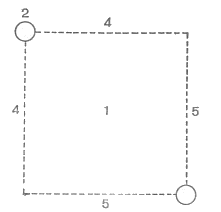
Abb.: Diagram 10
1. Area of sīmā
2. Eastern nimitta
3. Western nimitta
4. Lines which can be determined from the eastern nimitta
5. Lines which can be determined from the western nimitta.
According to this diagram, the nimitta are set diagonally opposed, but are not incomplete nimitta because the lines can be drawn to intersect indirectly. How far do the lines of the two sides drawn from the eastern nimitta extend? It can be determined that they will be extended to the point of intersecting the western nimitta as shown in (4). Both the lines from the western nimitta can also be understood to extend to the point of intersection with the eastern nimitta as shown in (5). In short, one nimitta is used as a marker for two sides. It is a real nimitta for one side but for the other side it is only the extended line of that nimitta. Perhaps this is called having a shadow as a nimitta? Khandha-nimitta, as explained by the Atthakatha-Acariyas is a shadow nimitta according to my view. They correctly explain that it is a defective sīmā, because the nimitta are not clear. Let the Vinaya-experts consider further how to settle this.
Sīmā without nimitta: the explanation ot the Atthakathā-Ācariyas is that when determining (the sīmā) the nimitta were not fixed or their directions were not noted at all. It does not seem possible to determine a sīmā without first fixing the boundary. If the area has been fixed but the ceremony of noting the directions is not performed, it will not exactly differ from the Pāli, as the Pāli only instructs to fix the nimitta, without specifying the procedure -- it appears that what is wanted is a true determination. I understand this to mean taking objects within the boundary-line as the nimitta-by doing so the line falls outside the nimitta and is cut off at all points, as strated in this diagram:
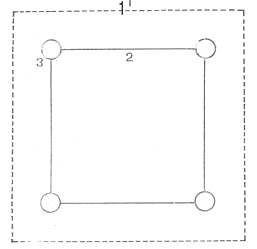
Abb.: Diagram 11: Nimitta taken within the boundary line
1. Originally intended lines
2. Now lines
3. Nimitta
It is regarded as defective sīmā because the line originally proposed cannot be seen. May the Vinaya-experts look into this.
The sangha which will determine the boundaries of a sīmā is not allowed to determine boundaries overlapping or superimposed on a previously determined sīmā. By doing so, the sīmā which is determined later will be defective and will not be regarded as a sīmā. Allowance is given for an interval or space in between (two sīmā) called sīmantarika.
For convenience in the practice related to sīmā, the sangha is allowed to give up a previously determined sīmā. The area which has been given up as a sīmā can be added to other plots of land, new boundaries can be drawn as desired, and a new sīmā determined. All that can be understood is that the customs of those times relating to claiming and transferring Crown Land were followed for convenience of practice. However so many Commentators have elaborated so much on overlapping sīmā that the subject is confused, giving rise to disputes and problems in the practice relating to sīmā, as I shall explain later under sīmāsankara.
The sīmā which the sangha is allowed to determine is called samāna-samvāsa-sīmā, which means the area of common samvāsa (communion). Bhikkhus who stay in this area have the privilege of participating in the uposafta, pavāranā and sangha-kamma together. It is the boundary of their concord. All bhikkhus living in this sīmā meet as a sangha or bring the consent of the bhikkhus who cannot enter the meeting. This is called the sangha in concord. They have the power to perform the four kinds of kamma as explained in Chapter XXIII. This samāna-samvāsa-sīmā is allowed to be determined once again as the ticīvara-avippavāsa (allowing the bhikkhus to be without the three robes in that area) excepting villages and their compounds located within that sīmā. When such a determination has been made, bhikkhus who stay without the ticīvara in that sīmā are not regarded as staying without them. It can be understood that the sīmā suitable to be determined as ticīvara-avippavāsa were sīmā without villages or village compounds situated within them. If it is a sīmā covering the area of villages or their compounds, or located within the area of villages, such sīmā should not be determined, but it has become traditional. I understand that because of the words in the kamma-vācā for determining excepting villages and their compounds, we should understand it as follows: when e sangha determines a samāna-samvāsa-sīmā covering villages and their compounds as ticīvara-avippavāsa-sīmā, whatever area is forest, that area can be used as an area of avippavāsa (can be without ticīvara), and whatever area contains villages or village compounds, that area cannot be used as an area of avippavāsa. In my opinion it is similar to the area of nadi- pārasīmā which will be explained later.
Here I shall explain the procedure of determining the sīmā according to present-day tradition.
It is the tradition that when a sīmā will be determined, the chanting to give up a previous sīmā must be performed first, just as if that area were really a sīmā. It is explained that if this is not done and if that area really were a sīmā, or it overlaps a previous sīmā, the determination will be valueless.
The area which will be determined as a sīmā must have the permission of the kingdom (or authorities, if the government is not a monarchy) to be visungāma, which means that it is separated from the area of villages. Why this is done I shall explain later under gāma-sīmā in the section of abaddha-sīmā. If in Pāli there were a further statement that a sīmā loses its status when there is no sangha occupying it. it would not be necessary to give it up beforehand. Since there is no such statement, it is necessary to do so. When the sangha will chant the giving-up formula, there must be a meeting of the bhikkhus living in that area or their consent must be brought, according to the procedure of sanghakamma. The assembly for the chanting of the relinquishing formula proceeds area by area until it is complete. I have heard that in former times, the head of that ceremony used a bamboo lattice with spaces big enough to accommodate each monk, linking them together within a forearmslength throughout the area. On the occasions when I have witnessed these ceremonies until I became the leader of the ceremony, the bamboo lattice was not used. Bhikkhus sat in rows leaving a space in between each other, according to the area to allow twenty-one bhikkhus to sit at each point The (former) way of giving up that sīmā goes beyond what is reasonable until it becomes attakilamathānuyoga (self-torment). If the chanting to give up is done once at the at the centre, such as in the Uposatha-hall, and then at each corner, corresponding to the nimitta, it will be suitable, once at each place This is more reasonable. If it is a mahā-sīmā, chanting can be done near the centre and repeated covering each place, because it is possible to know if that area used to be a monastery or not. It is then done as a formality.
The sangha_should chant to give up the ticīvara-avippavāsa first then chant to give up the samāna-samvāsa-sīmā. The chanting to give up can be done in advance or on that day. If it seems that it cannot be finished on that day, it must be done before.
The material to be used as nimitta must be prepared before. At present it is common to use stones because they are more convenient than other materials The size, according to the Commentary, is rather small. I prefer stones of larger size, large enough so that they are difficult to move. At present round stones are used placed in a pit and after the pit is filled in, a pillar or an arch-like structure is built over the sīmā-stone. Round stones roll about easily which I do not like, but they are frequently used. Placing them in pits is reasonable. If, after some time has gone by and that monastery is deserted, such nimitta may still remain in place, and indicate the extent of the old sīmā boundaries. Nimita above ground can be too easily moved from the area, bur the original objective was for them to be visible objects like the city markers called 'stone Pillars'. Ancient monasteries in Kam Phaeng Phet and Sukhothai cities used very large sīmā-markers fixed on the ground. I excavated at Wat Mahā Dhātu at Sukhothai, and found no nimitta-objects under the sīmā-markers. This means that they used the sīmā-marker itself as the nimitta. This agrees with the old tradition. According to the opinion of Somdet Phra Maha Samana Chao Krom Phraya Pavaresvariyālankarana, my preceptor, the nimitta stones should be set on the ground, not under the ground. They must be visible at the time of pointing them out. If trees were used as nimitta, they must be of the prescribed kind and big enough so that they cannot be moved to another place and planted there. If ponds or wells are to be used as nimitta, they should be those from which people normally draw water. These nimitta must be fixed as to direction. It is not necessary to be complete in eight directions. There must be sufficient to be linked together in the desired manner. It is common to use eight. According to my opinion, the mahā-sīmā should be complete in eight nimitta. Small sīmā should be complete in four, one at each corner, except if the arrangement does not agree with the compass points, and it is wished to mark in each compass point. Such sīmā must then have eight nimitta. If this is not done, the shape will be that of a diamond, as shown in the following diagram:
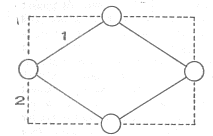
Abb.: Diagram 12: Diamond-shapeed sīmā
1. Lines between the nimitta
2. Originally proposed lines
When determining the sīmā, there must be a meeting of bhikkhus living in that area, that is, within the nimitta, or their consent must be brought if they cannot attend, according to the procedure of sanghakamma. The sangha should tell all sāmaneras or monastery attendants to prevent other bhikkhus from entering that area during that time. When everything is ready, the sangha should first note (point out) thenimitta. Noting the nimitta is perhaps not so important. It is not clearly stated in the Commentaries or Sub-Commentaries how it is to be done. The words for noting are found only in the Vimativinodanī. I was previously advised and have observed that senior bhikkhus perform it as follows: every member of the sangha need not go there. They should delegate only four bhikkhus to complete a sangha; those remaining are to wait in the Uposatha-hall. One bhikkhu points out the nimitta, beginning in the east and proceeding in order (clockwise). When noting the nimitta in whichever direction, they will stand within the sīmā facing the nimitta, leaving sufficient space so that the nimitta can be seen, and say the words of noting (pointing out) according to the direction. I will use the east as example: "Puratthimāya disāya kim nimittam?" which means, "What is the nimitta in the eastern direction?" Anyone can answer, a specific bhikkhu among them or a householder. I have observed the determining of the sīmā of Royal monasteries. His Majesty the King and members of the Royal Household responded together. The response indicating that a stone is the nimitta is: "Pāsāno bhante," which means "A stone, Venerable sir." For a tree the response ls: " Rukkho bhante," which means "A tree, Venerable sir." The bhikkhu who points out the nimitta should respond specifically: "Eso pāsāno nimittam" which means "That stone is a nimitta", or: "Eso rukkho nimittam" which means "That tree is a nimitta", according to the kind of nimitta. These are the main points of importance in specifying the nimitta called 'noting'.
The nimitta are noted progressively until the last one. For instance, if it involves eight nimitta, (the last one to be noted is) in the northeastern direction where they ask: "Uttarāya anudisāya kim nimittam?" which means "In the northeastern direction, what is the nimitta?" If they stop at this point, it is regarded as an incomplete nimitta as stated above. They must continue around, and once again point out the nimitta in the eastern direction: "Puratthimāya disāya kim nimittam?" as was initially done, and then return to the Uposatha-hall.
Following that, one bhikkhu who is clever in chanting the kammavācā and able to recite, not being hoarse, will chant the kammavācā in determining the area inside the nimitta as a samāna-samvāsa-sīmā with a ñatti-dutiyakammavācā according to the formula in the Uposathakkhandhaka in the Maha-vagga, which I shall treat in a separate chapter, in the section on kammavācā. At the completion of the anusāvanā, that is, at the words: "So bhāseyya", the area inside the nimitta -- explained as reaching down to the water supporting the earth (down to the liquid magma) -- has become the samāna-samvāsa-sīmā. It is the area of the same samvāsa and the same uposatha, and the places where the nimitta are fixed indicate the areas outside the sīmā. The point of limiting the depth of the sīmā will be seen, for instance, if a pool is dug within. that sīmā. Monks who are in the pond have the same samvāsa. They have the privilege to participate in the meeting or to bring their consent. It is also the tradition to chant the determining of the samāna-samvāsa-sīmā as the ticivara-avippavāsa. It does not have the advantages it used to, and can be done or not done as desired.
All activities, namely relinquishing (the previous sīmā), noting the nimitta, and the chanting to determine (the new one) must be done within the sīmā. If these have been done outside the sīmā, that kamma is defective (kamma-vipatti), and so that sīmā (if used) will also be defective (sīmā-vipatti). Presumably this is the cause of the old tradition that a stone nimitta is buried in the middle of the Uposatha-hall, to signify that the sangha has already determined that area. The Pāli Commentaries and Sub-Commentaries say nothing about this, but otherwise, I see no purpose in burying the stone there. The custom to determine the sīmā while standing probably derives from the term "thito", which can mean "standing", "located", or "remaining there". I think that this term is taken from the Pāli of the Parivara showing the features of a defective simā: "bahisīme thito sīmam sammannati" here meaning "standing", translated as "standing outside the sīmā, he determines the sīmā."
The author of the Atthakathā suggests determining a two-section sīmā (inner and outer), a process which may be summarized as follows. In performing sanghakamma (bhikkhus) must be called to the meeting, or send consent: for this, a large sīmā is inconvenient, so a smaller sīmā is determined as the inner one, leaving a suitable sīmantarika (space between the sīmā), further explained as not wider than one forearms-length and one handspan, and not narrower than four fingers width. Then, the large sīmā can be determined as the outer one. There can be many such small sīmā called khandasīmā, having the sīmantarika surrounding them, just as an island is surrounded by water. The large sīmā is called mahāsīmā. An example is given below.
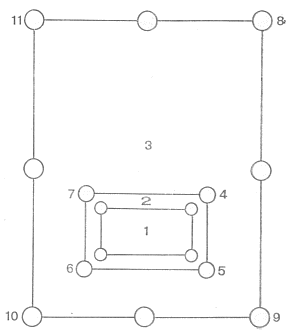
Abb.: Diagram 13: Mahāsīma containing khandasīmā and sīmantarika.
1. khandasīmā.
2. sīmantarika.
3 mahāsīmā
4-7 inner nimitta of mahāsīmā in the Eastern (4), Southern (5), Western (6) and Northern (7) quarters.
8-11 outer nimitta of mahāsīmā in the Eastern (8) Southern (9), Western (10) and Northern (11) quarters.
(The sangha) should stay within whichever sīmā is being determined. First the khandasīmā is determined according to the procedure already explained. Then, when determining the mahāsīmā, the nimitta fixed at the sīmantarika are noted first. How to point them out is problematical. For the nimitta of the mahāsīmā, the alternating method is: in the Eastern quarter, take (note of) nimitta (number) 8 as in the East, nimitta 4 as in the West; then, in the Western quarter the arrangement is the same. Take nimitta 6 as in the East, nimitta 10 as in the West. The consecutive method is: in the Eastern quarter take (note of) both Eastern nimitta, and in the Western quarter take (note of) both Western nimitta. The Commentator (of the Parivara) does not mention this. The Sub-commentator in the Vimativinodanī counts alternately. He suggests that when determining nimitta number 6 of the sīmantarika in the Western quarter of the khandasīmā, stand behind the nimitta facing the East and say: "Puratthimāya disāya kim nimittam?" "What is the nimitta of the Eastern quarter?" I learnt the following explanation from Phra Candragocaraguna (Candaramsi Yim), the Lord Abbot of Wat Makutaksatriyārāma, my Kammavācā-Ācariya, when I stayed to learn Vinaya with him. He said that the Theras (Elders) of the Dhammayuttika-Nikāya determined the (diagonally) opposite nimitta. For example, to determine nimitta 4 of the sīmantarika in the Eastern quarter of the khandasīmā, stand behind the Western nimitta of the khandasīmā facing the East. Aim at determining nimitta 4 and say: "Puratthimāya disāya kim nimittam?" Noting the opposite (corner) like this can be done, because in former times when fixing a large sīmā, it was inevitable that wherever (one stood) one would be separated from the noted nimitta [That is, in both cases it might be difficult or impossible to see the nimitta.]. I take his explanation to mean that the Theras of the Dhammayuttika-Nikāya count the nimitta in the Eastern quarter as being determined all together, and likewise in the Western quarter they note its nimitta all together. After the passing away of my Ācariya, I participated in determining an inner and outer sīmā like this atWat Makutaksatriyārāma itself. Somdet Phra Mahā Samana Chao Krom Phraya Pavaresvariyālankarana, my Preceptor, presided over the sangha. Somdet Phra Sangharāja (Pussadeva Sā) noted the nimitta and announced the kammavācā. He followed the above procedure as given by my Ācariya.
Determining a two-section sīmā is only difficult regarding noting the inner nimitta of the mahāsīmā; after that it is not difficult and should be done by the method already explained -- after the outer nimitta have been noted, the determination of the mahāsīmā is chanted. The areas of the two sīmā are different and are said not to overlap. Sīmantarika is not baddhasīmā but is regarded as gāmasīmā.
I am not at all convinced of the usefulness of determining a two-section sīmā. Formerly it would have been of benefit as the mahāsīmā would have embraced many monasteries. Those staying within a mahāsīmā are regarded as staying within the same sima. They would derive the desired benefits: for example, the area of nissaya and gains (lābha) are shared by all living in that sima; the property of the sangha could be stored in one place, and distributed among them; and sangha-kamma can be conveniently carried out.
The baddhasīmā at present is of three kinds, namely:
In the Mahāvagga another kind of sīmā is mentioned, called nadīpārasīmā, meaning the sīmā of the river-bank, that is, the sīmā is fixed to cover both banks with the river in the centre, as shown in the following diagram.
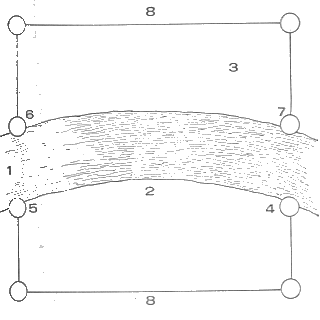
Abb.: Diagram 14: Sīmā of the river-bank
1. River
2. Inner bank
3. Outer bank
4. Nimitta of the upper inner bank
5. Nimitta of the lower inner bank
6. Nimitta of the lower outer bank
7. Nimitta of the upper outer bank
8. Line connecting the nimitta.
This is the procedure the Commentators recommend). Determine the nimitta of the inner bank beginning from the upper nimitta (4); then circle around until the lower inner nimitta (5) is reached; then note the lower nimitta (6) of the outer bank; then continue around to the upper nimitta (7) of the outer bank; and finally go back to (and re-determine) the upper nimitta 4 of the inner bank. Such a determination joins the two banks together in the same sīmā and excludes the river itself, just as the area of the same district can cover two shores.
If there is an island in the river it can be included within the sīmā if desired. Having determined nimitta 5, determine the nimitta at the lower end of the island. Then (cross) to determine nimitta 6, and continue circling around. Having determined nimitta 7, determine the nimitta at the upper end of the island. Finish by repeating the determination of (the first) nimitta (4). By this means, the land on the island falls within the sīmā also.
This nadīpārasīmā is a special allowance for villages with regular boat traffic and a wharf, or a permanent bridge, This sīmā is no longer determined. I mention it here only for completeness, for I see no value in it. Why would anyone determine it, when all that will be gained are difficulties? There are certainly benefits in determining a large sīmā, which I have already discussed. To determine a sīmā bridging both banks of a river has the purpose to extend those advantages to the sangha living on the other bank. Let the vinaya-experts consider this.
If the sangha itself does not determine the sīmā as stated above, the area samaggī (concord) is fixed as within the the legal boundaries of the village or town where the sangha lives.This is called gāmasīmā or nigamasīmā. (The bhikkhus) living there have the same samvāsa (communion) and the same uposatha.
The term "house/village" here is meant in both its narrow and broad senses. It can mean the living-place of one family, or one, two, three or more houses: all are called "houses" as in the expression "Mr. Kaew's house". When the houses form a group, it is called a village, perhaps called "Kaew's-house". In this case the Atthakathā-Ācariyas suggest that the area within which the headman collects taxes should be taken to be the village. So "Kaew's-house" can be specified either as the area with the same sīmā or as the headman's district (Tambol).
The term nigama includes many villages together, such as many headmen's villages collected into an administrative district.
In this way, the area of a village and of nigama are not the same. But in the Pāli they are not differentiated. When the area of the village has already been allowed, why is the area of nigama mentioned ? Moreover, the Atthakathā-Ācariyas add the area of the city, too. I have investigated this and have found two meanings.
The Atthakathā-Ācariyas describe a certain area within a village which the King decrees as a separate village, or as a section separate from the village, and gives it to someone. As that area is separated from the gāmasīmā, it is called visungāmasīmā. Both visungāmasīmā and the normal gāmasīmā are similar to baddhasīmā, except that are they not to be determined as ticīvara-avippavāsa. The Atthakathās point out that the visungāmasīmā should be understood as follows: In ancient times the King would grant a certain area to a person who had served the country -- such as a warrior -- to administer that group of people in times of peace. The owner of the land had the privilege to collect taxes, but the portion to be returned to the King is not known. In time of war, the King drafted the owner of the land and his subjects to form a battalion to fight for him. This tradition was still practised in the Buddha's time as can be seen from the Sonadanda Sutta (Dīgha-Nikāya, Sīlakhandavagga). Brahmin Sonadanda received Campā city as brahmadāya from King Pasenadi of Kosala, and ruled over it. The term brahmadāya literally means "given by brahma", here meaning royal gifts for some reason such as a general reward. The tradition in Siam is that the King appoints members of the Royal Family as krom (Lords) with the power and privilege to appoint a chao krom (Councillor), a palatkrom (Under-secretary), and a samuhabanjī (Accountant).
The King himself appointed men as ministers and directors of Departments. All of these were granted so many rai of fields under cultivation, such as ten thousand rai or one thousand rai according to their rank or status. This is called sakdinā. Such appointed Lords can make use of those men liable for conscription who are under their control, but they have to pay money to the government according to their rank and the number of their subjects. The royal permission to hold sakdinā no longer follows this original model, but has evolved to be a measure of status and a scale of fining appropriate for transgressors, or the holder himself, when he does wrong. Nevertheless, the custom does seem to have originated from the ancient tradition.
The visungāmasīmā is comparable to the present practice of granting exclusive rights to forests or mines to reputable people or companies. The Commentator's interpretation is widely accepted and has come down as a tradition. A King who is a Buddhist Patron wishing to assist the sangha issues a decree to make the site for a wat (monastery) a visungāmasīmā, according to the royal tradition, also being the royal permission to build a wat. However, this royal permission is granted specifically for the precincts of the Uposatha-hall, which amounts only to a few square metres. This seems to be playing about and is objectionable to those who observe Vinaya very strictly. Besides being trifling, the government is not supposed to fix the area and the sangha is able to expand the monastery as it likes, which is too lax. The current tradition is that the King grants the total area of the monastery, which is better. The area of visungāmasīmā is not secure, in the same way as the government may take back the concession for a forest or mine. Such areas of visungāmasīmā should not be left like that, but should be determined as baddhasīmā
It is said that in uninhabited forests, the sangha limits the area of concord with a radius of seven abbhantara, beginning from the edge of the sangha itself. The diameter is therefore fourteen abbhantara. One abbhantara is twenty-eight forearms-lengths or seven wah (1 wah = 2 metres) in length. Seven abbhantara are therefore forty-nine wah (nearly 100 metres). The Atthakathā-Ācariyas say monks who dwell within this araññasīmā (forest sīmā) enjoy advantages, (but) they may not stay apart from their ticīvara -- which contradicts the Vibhanga on the second sikkhāpada, Cīvaravagga of the Nissaggiya Chapter -- and that ticīvara-avippavāsa is limited only to a specially determined baddhasīmā. I do not understand how this is possible.
The surface of a body of water cannot be determined as a sīmā, but it is said that an area of concord can be limited to within the radius measured by the distance water can be thrown by an average man. This is called udakukkhepa (limited by water). The Pāli describes three kinds of water-bodies:
River means water which flows, which has a current and is not stagnant. The Atthakathā-Ācariyas describe the characteristics of a river as follows:
According to the Commentator's above statement, rivers which rise in the highlands and flow down to the distant ocean, are full of water in the rainy season only. In summer they are dried up to the extent that boats have to be pulled through the remaining water, or people have to dig into the river-bed itself to find water, as seen in the River Ping in Thailand beyond Pak Nam Po. This is also called "river". The Commentator's standards are reasonable because people still think of it as a river and it is still a means of public transport.
Canals, however, which are dug to connect an area to the river, or to connect one river to another, are not regarded as rivers, but as gāmakhetta (village boundaries). When the stream widens the canal banks until it no longer appears man-made, such as the canal in Pakret, Nondaburi, it can be included as a river. A canal which has not been widened in this way is still counted as a canal dug by men such as Klong Lat Luang in Phra Pra Daeng and the Bhasee Charoen Canal in between the Bangkok Yai Canal and the Nakorn Chaisee River. However, the Bangkok Yai Canal which is the old river bed can be included in "river".
The area of concord on water is limited by the distance water can be splashed. I have experimented with this. It covers approximately a distance of three wah (or about six metres). It is much narrower than the area of sattabbhantara-sīmā. I understand that it was limited in accordance with the national traditions of the day. The law gives rights to owners of houses built on the riverbank, such as this country's current tradition to collect fees from boats or rafts moored here. That right is limited within the distance that water can be splashed from the bank. Beyond that it is a public waterway and the law prohibits anyone from having rights over it. The fixed area of the seven abbhantara for the forest is perhaps the same. Buildings in the forest without a surrounding fence possibly are limited by the area of that building itself.
Samudra means salt water beyond the estuary of a river which we call the sea. If between two enclosing banks, it is called a gulf, whether small like Luk Island Gulf, or as large as the Gulf of Siam: that which is situated between the shore and an island, such as that between Ngob Peninsula and Chang Island in Trat Province: that with one bank becoming open ocean beyond that, such as that at Nakorn Sri Thammarat and Pattani (provinces) and the area beyond the Vietnamese Peninsula: all these are called samndra. The sea boundaries are at present limited by International Law. I have learnt that it is limited out from the shoreline to a distance of three miles, or between 120 and 135 sen (1 sen = 20 wah) Within this area, the country has ownership privileges. Beyond this, the sea becomes international waters, but the islands in these waters belong to the country. In the Vinaya the limits on the sea by udakukkhepa are perhaps related to the river limits because the cities where Buddhism first spread in India do not touch the sea. Perhaps sea laws did not exist at that time. Therefore, the limits of the river area are used in regard to the sea. However, it is advisable to measure the shoreline from where the water is at its lowest at low tide.
Jātasara means naturally confined water, called lakes, lagoons or sea-lakes. They cannot easily be divided up as to shape or size as they have different names in different places -- but probably two types (should be distinguished).
The first is genuine jātasara, the second is a clogged-up river. That is, the course has changed until the silt blocks a section of it off from the new course. Sea-lakes are explained as a part of the sea that a silt bank has sealed off from the sea outside, like the sea-lake at Pattalung. The flowing current of a river distinguishes it from the still-water lakes and lakes and lagoons called jātasara.
Sanghakamma performed on these three kinds of water-surfaces can be performed on a boat or raft moored to a pole or anchored, that boat or raft must be at least as far offshore as the distance water can be splashed and must not be moving. It is allowed to perform sanghakamma on a platform built out over the water. The area of concord is one water-splashing distance all around the sangha's edge.
Can uposatha and sanghakamma be performed with the status of udakukkhepa (determined) when the river-bed is sandy and at its deepest point must be dredged to allow boats to pass? Sandbanks not covered at highwater are counted as the bank if close to the bank, or as islands if distant from it and should be counted as gāmakhetta (in the village boundaries) and cannot be determined as udakukkhepa. When the river still covers the surface of a sandbank, especially during the rainy season, still having the nature of a river, still a public waterway not subject to ownership, that bank's surface can be determined as udakukkhepa. The Atthakathā-Ācariya's explanation regarding sandbanks perhaps refers to a case like this. If the boundary is expanded according to laddhupāta, the distance a ball of clay can be thrown, the limit around houses and their compounds without boundary-markers, it will be suitable for dry places. The distance of laddhupāta is certainly further than that of udakukkhepa, and should be used.
Bodies of water that people have blocked off, like a river dam, a weir, an area of the sea where fish-traps are built, or swamps or lagoons walled up for irrigation by farmers, may not be used as the area of udakukkhepa; if kamma is to be performed nearby, they must be avoided by the breadth of one udakukkhepa. When the original (earth)-surface has been raised until there is no longer any water and only traces remain to be seen, it loses its old status (and cannot be used as udakukkhepa).
Gāmasīmā, sattabbhantarasīmā, and ukakukkhepa are members of the same class, called abaddhasīmā, each being limited as has been explained.
Most Teachers understand the prohibition on determing overlapping sīmā much too widely, explaining it as intermingling of sīmā in many different ways. The essential is summarized as follows:
1) Because there is nothing in the Pāli about a baddhasīmā losing its nature by itself, without the sangha relinquishing it, they say that even when deserted, ownerless, and with nothing left to indicate it as a sīmā, it still has not lost its nature and is certainly still a baddhasīmā. If a later sangha, not knowing about it, determines a new sīmā overlapping the original one, the new one will be defective. If a river's current has cut away the earth within the sīmā until it collapses and becomes part of the river course, that area of the river must still be a baddhasīmā. Were a later sangha, not knowing about it, to come and determine that part of the river as udakukkhepa and perform kamma there, and a bhikkhu in a boat strayed into the area (of the original baddhasīmā), even though he were not to enter the boundary of udakukkhepa, that kamma is still spoilt. This interpretation of the Teachers is based on the previously-explained point that the baddhasīmā reaches down to the "water" (of magma) underground. Therefore a later sangha should first chant the relinquishment in all places, as mentioned before, so that no problems arise: this is an appropriate safeguard.
I have never heard of a sangha chanting relinquishment for a body of water, which is not counted as a sīmā, before determining it as udakukkhepa according to its characteristics. This may be because it is not practical, or else because it is agreed that a sīmā eroded by a river has lost its characteristics by natural forces, but this last is only speculation. I once saw a real example of an eroded sīmā at Wat Yai Wung in Samut Songkram when my boat stopped there. The villagers said that that place was part of the original Uposatha-hall grounds when the river followed a different course. I saw that the river had eroded the banks almost up to the Uposatha-hall. This is one difficult matter regarding sīmā.
2) Many Teachers cite the first Mahāpadesa (Great Standard) -- that unprohibited things that accord with unsuitable things, and differ from suitable things, are themselves unsuitable -- in relation to this: trees growing in two baddhasīmā, such as a khandasīmā and a mahāsīmā, with branches touching, or a banyan tree growing in one whose aerial roots go down to the ground in another sīmā. They define those sīmā as overlapping, and say the sangha cannot perform kamma in one until those branches or roots have been prevented from touching, or else must meet together with the sangha of the other sīmā -- whose chanda may not be brought, as chanda is not brought from those of another sīmā. This is the opinion of the Atthakathā-Ācariyas. It became the subject of disagreement between later teachers. Is there a similar fault regarding trees or banyan-roots growing in a gāmasīmā and a baddhasīmā? The Sub-commentator of the Vimativinodaī holds that there is no fault. He explains that when a gāmasīmā is the "dwelling-place" of a baddhasīmā, (the latter) is a dependent sīmā; and when a baddhasīmā depends on a gāmasīmā, it "rests on" it -- these two kinds do not overlap. Otherwise, why would a baddhasīmā be determined when the Exalted Buddha's permission has already been given (that is, to take the village as the sīmā)? From this, there is no fault in the case of the trees or banyan-roots touching two sīmā, invoking Mahāpadesa number four -- anything for which permission has not been given that accords with the allowable, and differs from the unallowable, is itself suitable. Since then the Sub-commentator's (in the Vimativinodanī) opinion has received general approval -- if it isn't taken like that, it will cause great problems. If a tree causes overlapping, why has no one mentioned electricity wires -- I suppose because trees are "things" but electricity poles and wires aren't. [It has been heard that in Burma the electricity wires are disconnected if a sanghakamma will be performed. This leads one to think of the air which flows into the sīmā. Should it too be disconnected]
3) Because of the previous point, the commentators recommend that when sanghas of two groups will perform sangha-kamma at the same time, they must be separated. If in a forest, there must be a separation of at least one abbhantara, or if on water, of at least one udakukkhepa. As these distances are the radius of each group, so the total separation between the edges of the two groups must be three abbhantara or three udakukkhepa. If this were all, there would be no real difficulty, but if they extended their explanation to gāmasīmā as well problems would arise -- but they don't, so that's that!
4) For doing sanghakamma on water -- a river for example -- the Commentators prohibit tying the boat or raft to a pole or tree on the bank. If that is done, they say that the udakukkhepa overlaps the gāmasīmā, pointing out that the characteristics of those sīmās are visabhāga, not compatible. I heard that this point gave rise to a large vivāda (contention) in Sri Lanka. Not so long ago, one group of the sangha performed sanghakamma on water, on a boat or raft moored in front of a bridge coming from the bank. There was a gangplank from the bridge to the place of sanghakamma, which was taken away at the time of performing the sanghakamma so that the place was separated from the bridge, but they were still within water-splashing distance. An opposing group of bhikkhus called it sīmāsankara. Both opinions found support and could not be reconciled. I understand that if the boat or raft is tied to a pole or tree on the bank, they are most likely within udakukkhepa of the bank, and so kamma performed there does not fulfil the characteristics of udakukkhepa -- being near a bridge is the same -- but that it is not sīmāsanikara. This follows the supposition that householders on the bank have rights over the water as far as one udakukkhepa offshore, according to the custom of those times. So the area of performing kamma within udakukkhepa must be another udakukkhepa offshore -- that is, two altogether. A bridge coming from the bank is for this purpose the same as the bank, and requires the same separation. Performing kamma near or far from sections of water that people have blocked off should be understood in the same way.
For ease of understanding, the prohibition on determining a sīmā overlapping or touching on an already determined sīmā may be compared with the rights of the owners of adjacent blocks of land. If a dispute arises, the court will decide in favour of the first (earliest) owner, who has legal rights. Just as that late-comer's claims do not stand, so the determination of a sangha whose sīmā overlaps an earlier one is declared invalid by the Great Teacher. Why haven't the various Teachers kept sight of this spirit? Stretching the meaning of overlapping to include intersecting tree branches or drooping banyan-roots is not worth calling intermingling. The custom in those days was to make a separating strip between Mr. Red's field and Mr. Black's, to avert lawsuits between the two owners: giving permission for a sīmantarika in between (two sīmā) is just the same. With this understanding of the prohibition against determining overlapping or adjoining sīmā, one should be able to work out what is or is not sankara correctly following the Lord Buddha's explanation."
Zurück zu Kapitel 15: Die Entgegennahme des Mahāvihāra